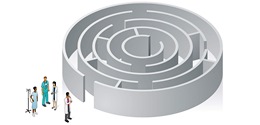Member or Patient? Either way you slice it, they are the customer.
Dennis Bolin, Member Engagement/Chief Marketing Officer
04/11/2016

“Tomato, tomato”… “Patient” and “member” must both mean “Customer” for this to work
“Member/Patient” … any way you slice it, it’s really the customer
“Customer Experience” is a term I hear and read everywhere these days. Amazingly, in our current Twitter-driven language I recently saw it shortened to CX. That abbreviation only adds to the confusion and challenge of defining what we mean by the customer experience. For years regional health plans have claimed customer service – we primarily pointed to our customer service reps – as a competitive differentiator. But today, consumer expectations are shaped by their daily experiences and health care is struggling to keep up with those expectations. Some of you have heard me say “A customer’s last best experience anywhere becomes their expected experience everywhere.” It isn’t enough to compete against United, the Blues and Kaiser on customer experience, now we compete against Amazon and upstarts like Oscar. And then there is the former President of United launching VC backed Bright Health, which he vows will be “consumer-centric” and technology-driven.
So how do regional plans keep up, let alone get ahead, when it comes to delivering an experience members value, pay for, and stay loyal to? What advantages do we leverage?
I am observing Alliance members beginning to work closely with their provider owners/sponsors and physicians to develop an integrated customer experience. The vision is that a customer’s experience should be different if they use all three components for their health and well-being and care. As in all other areas of integration, this requires a shift in mindset. As a CEO said recently in a survey, with one of our business partners: we will struggle creating a superior customer experience until we begin to treat the health plan member and physician and hospital patient as though they are the same person.
Alliance members are making strides. Some examples of what plans, systems and physicians are jointly working on:
- Implementing a single CRM system so the entire enterprise can share the same “picture” of the member/patient
- Evaluating the member/patient “journey” – identifying all the touchpoints the various pieces of the system have with the consumer to determine overlaps, smooth hand offs, the need for common information, and simplifying the consumer’s movement through all the various elements of our delivery and plan system
- Emphasizing integrated care management
- Managing the costs of care so they can offer a predictable, stable premium price in the market
- Creating financial processes so the consumer receives a comprehensive, easy to understand financial statement covering all their care
- Streamlining their business processes so they are “easier to do business with”
- Partnering with technology vendors to simplify the enrollment process and/or to provide a tailored, expansive set of consumer technology tools.
- An area Alliance members are just starting to work on is transforming their various websites (one for the plan, one for the hospital, one for the physician group) from “online brochures” to integrated sites that engage consumers and assist them in all aspects of their health care
To post comments, Click Here to Login
